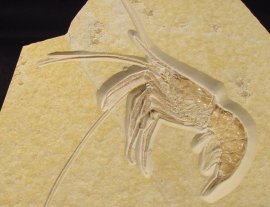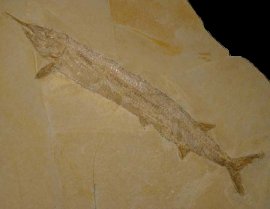Fossils from Solnhofen
 |
 |
When talking about Solnhofen limestone, normally the whole limestone deposit within the Altmuehltal valley is what this is considered. The classic limestone material can be found in Eichstaett, Solnhofen and other Quarry Sites. The limestone is approx 144 to 150 million years old, and stratigraphic they belong to the lower Tithonium. According to the newer stratigraphic rules, it is called the Solnhofen-Formation.
More than 700 different fossil species are known. Certainly fascinating are rare vertebrates like pterosaurs or the famous first bird, Archaeopetyx. Less spectacular, but not less interesting, are fossils from cuttlefishes (e.g. Plesiotheutis), Ammonites (e.g.. Suplanites, Neochetoceras), Fishes (Tharsis, Leptolepides, Aspidorhynchus and many more) , Crustaceans (e.g. Aeger, Eryma, Eryon, Cyclerion) and Insects (Elcana, Myrmicium for example). Because of the subtle texture of the limestone the fossils are very well preserved. Many fossils show plenty of details and even soft tissues are commonly seen.
The limestone material has been used since roman times. Romans used the material for their buildings (Floor and Wall Tiles). From medieval times on, it was also used for roof tiles. Unfortunately those so called "Legschieferdaecher" (This is the name of those Shale-Roofs) are not very common today. Later on, the Solnhofen Limestone was sold as tiles all over the world. This is still the most seen usage of this material. Also in Arts this material was and is used, for memorial stones or relief art.
The biggest economical boom for the region was the discovery of lithography. Alois Senefelder discovered the printing method called lithography in the year 1739. The limestone was the best stone for this because it's subtle texture. Nowadays lithography does not play a bigger role anymore, however, it is still used for artwork.
Nowadays the Solnhofen limestone is advertised and sold as Floor and Wand tiles in different designs (unaltered natural surface, sanded or polished). A second - but smaller - economic sector is concrete manufacturing. Almost all material which cannot be used for tiles will be used for concrete.
Recognizing the multitude of quarries in the region, and the amount of material which is quarried, it is clear how rare fossils from that region are. The supposed mass of fossils is only explainable because of the industrial use of that material over the centuries.


